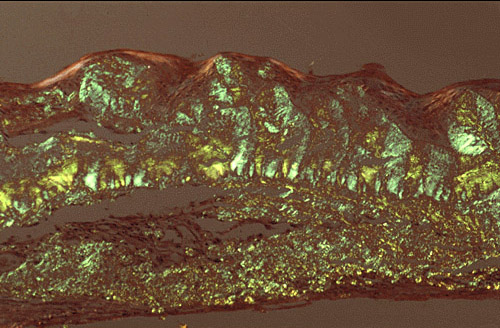Gelatinous Drop-like Corneal Dystrophy on:
[Wikipedia]
[Google]
[Amazon]
 Gelatinous drop-like corneal dystrophy, also known as amyloid corneal dystrophy, is a rare form of
Gelatinous drop-like corneal dystrophy, also known as amyloid corneal dystrophy, is a rare form of
corneal dystrophy
Corneal dystrophy is a group of rare hereditary disorders characterised by bilateral abnormal deposition of substances in the transparent front part of the eye called the cornea.
Signs and symptoms
Corneal dystrophy may not significantly affect ...
. The disease was described by Nakaizumi as early as 1914.Nakaizumi, K. : A rare case of corneal dystrophy. Acta. Soc. Ophthal. Jpn. 18: 949-950, 1914
Presentation
The main pathological features in this dystrophy are mulberry-shaped gelatinous masses beneath thecornea
The cornea is the transparency (optics), transparent front part of the eyeball which covers the Iris (anatomy), iris, pupil, and Anterior chamber of eyeball, anterior chamber. Along with the anterior chamber and Lens (anatomy), lens, the cornea ...
l epithelium. Patients suffer from photophobia, foreign body sensation in the cornea. The loss of vision is severe. The amyloid
Amyloids are aggregates of proteins characterised by a fibrillar morphology of typically 7–13 nm in diameter, a β-sheet secondary structure (known as cross-β) and ability to be stained by particular dyes, such as Congo red. In the human ...
nodules have been found to contain lactoferrin
Lactoferrin (LF), also known as lactotransferrin (LTF), is a multifunctional protein of the transferrin family. Lactoferrin is a globular proteins, globular glycoprotein with a molecular mass of about 80 Atomic mass unit, kDa that is widely repre ...
, but the gene encoding lactoferrin is unaffected.
This form of corneal amyloidosis appears to be more frequent in Japan.
Genetics
A number of mutations causing this disease have been described in the M1S1 (TACSTD2) gene encoding ''Tumor-associated calcium signal transducer 2'', but not all patients have these mutations, suggesting involvement of other genes.Diagnosis
Treatment
Recurrence within a few years occurs in all patients followingcorneal transplantation
Corneal transplantation, also known as corneal grafting, is a surgical procedure where a damaged or diseased cornea is replaced by donated corneal tissue (the graft). When the entire cornea is replaced it is known as penetrating keratoplasty a ...
. Soft contact lenses are effective in decreasing recurrences.
References
External links
{{DEFAULTSORT:Gelatinous Drop-Like Corneal Dystrophy Disorders of sclera and cornea